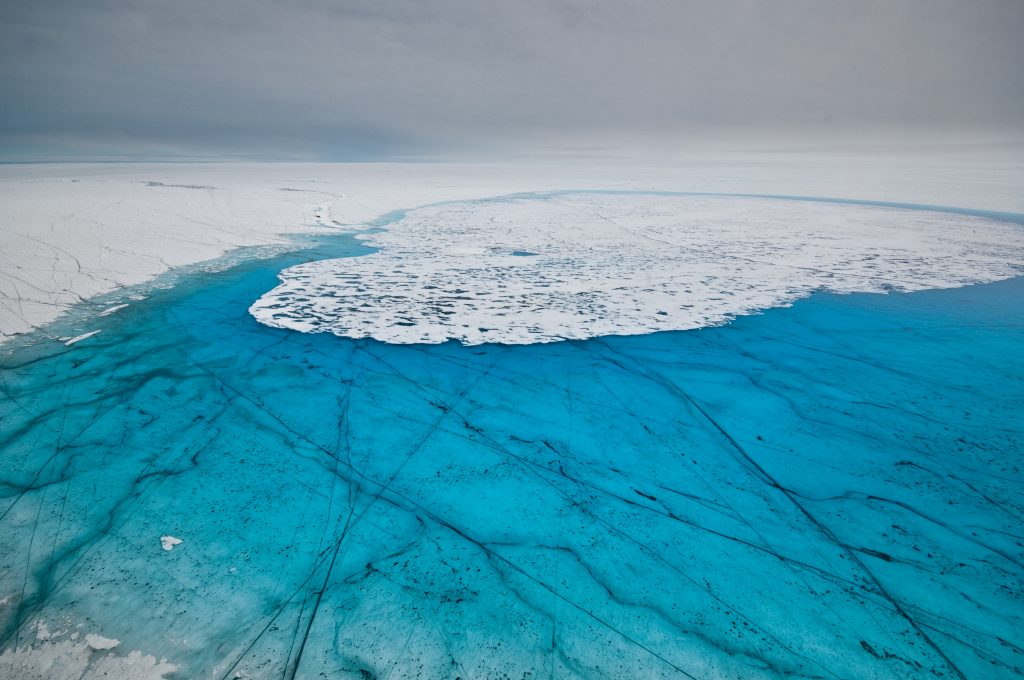Scientists discover massive ice loss in Greenland glacier
- April 8, 2024
- 0
The melting rate under the glacier at 79° north is 130 meters per year. Radar measurements from land and aircraft in northeastern Greenland show the extent of ice
The melting rate under the glacier at 79° north is 130 meters per year. Radar measurements from land and aircraft in northeastern Greenland show the extent of ice

The melting rate under the glacier at 79° north is 130 meters per year. Radar measurements from land and aircraft in northeastern Greenland show the extent of ice loss experienced by the 79°N glacier. Findings from the Alfred Wegener Institute show that the thickness of the glacier has decreased by more than 160 meters since 1998. This significant decrease is primarily due to warm ocean currents melting glaciers from below.
High temperatures cause lakes to form on the surface, and the water from these lakes flows into the ocean through huge channels in the ice. According to the research team’s report published in a scientific journal, one of the channels had an altitude of 500 meters, but the ice on it was only 190 meters thick. cryosphere .
A rural camp in northeastern Greenland was one of the bases for the deployment of autonomous measuring devices with advanced radar technology on helicopters in the hard-to-reach part of the 79° north glacier. Measurement flights using polar aircraft and satellite data from the Alfred Wegener Institute, Helmholtz Center for Polar and Marine Research (AWI) have also been included in the scientific study, which has now been published in a scientific journal. cryosphere.
This study examines how global warming affects the stability of a floating ice tongue. This is of great importance for the remaining ice shelves in Greenland and Antarctica; because ice shelf instability often causes ice to flow faster, resulting in further sea level rise.
The first author of the paper is AWI glaciologist Dr. “Since 2016, we have been using autonomous vehicles to make radar measurements on the 79°N glacier, with which we can determine the rate of melting and thinning,” says Ole Zeising. “We also used aircraft radar data from 1998, 2018 and 2021, which showed changes in ice thickness. We were able to measure that the 79° North glacier has changed significantly in recent years due to the impact of global warming.”
The study shows how the combination of warm ocean flow and atmospheric warming affects the floating ice tongue of the 79°N glacier in northeast Greenland. A group of AWI oceanographers recently published a model study on this topic. The unique set of observational data presented demonstrates that extremely high melt rates occur over a wide area near the transition to the ice sheet. Additionally, large channels form on the underside of the landside ice, possibly because water from large lakes flows through the glacier ice. Both processes have led to strong thinning of the glacier in recent years.
Due to its extraordinary melting rate, the ice at the tongue of the floating glacier has thinned by 32% since 1998, especially from where the ice contacts the ocean. In addition, a 500-meter high channel was created at the bottom of the ice, extending towards the land. Researchers explain these changes by warm ocean currents in the space beneath the floating tongue and the flow of meltwater on the surface as a result of atmospheric heating. An unexpected discovery was that the melting rate has decreased since 2018. One possible reason for this is cold ocean currents. Professor Dr. who took part in the research. “The fact that this system reacts in such a short time is impressive for systems that are essentially motionless, such as glaciers,” says Angelica Humbert.
“We expect this floating tongue of glacier to break up in the next few to decades,” explains the AWI glaciologist. “We started to study this process in detail to get a maximum understanding of how the process was going. Although there were several similar breaks in the ice shelf, we were only able to collect the data later. As a scientific community, we are in a better position now because we had created a really good database before the accident.”
Source: Port Altele
As an experienced journalist and author, Mary has been reporting on the latest news and trends for over 5 years. With a passion for uncovering the stories behind the headlines, Mary has earned a reputation as a trusted voice in the world of journalism. Her writing style is insightful, engaging and thought-provoking, as she takes a deep dive into the most pressing issues of our time.